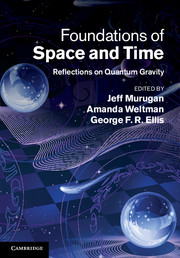Book contents
- Frontmatter
- Contents
- List of contributors
- 1 The problem with quantum gravity
- 2 A dialogue on the nature of gravity
- 3 Effective theories and modifications of gravity
- 4 The small-scale structure of spacetime
- 5 Ultraviolet divergences in supersymmetric theories
- 6 Cosmological quantum billiards
- 7 Progress in RNS string theory and pure spinors
- 8 Recent trends in superstring phenomenology
- 9 Emergent spacetime
- 10 Loop quantum gravity
- 11 Loop quantum gravity and cosmology
- 12 The microscopic dynamics of quantum space as a group field theory
- 13 Causal dynamical triangulations and the quest for quantum gravity
- 14 Proper time is stochastic time in 2D quantum gravity
- 15 Logic is to the quantum as geometry is to gravity
- 16 Causal sets: discreteness without symmetry breaking
- 17 The Big Bang, quantum gravity and black-hole information loss
- 18 Conversations in string theory
- Index
- References
17 - The Big Bang, quantum gravity and black-hole information loss
Published online by Cambridge University Press: 05 August 2012
- Frontmatter
- Contents
- List of contributors
- 1 The problem with quantum gravity
- 2 A dialogue on the nature of gravity
- 3 Effective theories and modifications of gravity
- 4 The small-scale structure of spacetime
- 5 Ultraviolet divergences in supersymmetric theories
- 6 Cosmological quantum billiards
- 7 Progress in RNS string theory and pure spinors
- 8 Recent trends in superstring phenomenology
- 9 Emergent spacetime
- 10 Loop quantum gravity
- 11 Loop quantum gravity and cosmology
- 12 The microscopic dynamics of quantum space as a group field theory
- 13 Causal dynamical triangulations and the quest for quantum gravity
- 14 Proper time is stochastic time in 2D quantum gravity
- 15 Logic is to the quantum as geometry is to gravity
- 16 Causal sets: discreteness without symmetry breaking
- 17 The Big Bang, quantum gravity and black-hole information loss
- 18 Conversations in string theory
- Index
- References
Summary
I argue that the common idea of applying standard quantization procedures to the space-time geometry at the Big Bang to obtain a Planck-scale chaotic geometry is likely to be wrong, whilst such a quantum-geometric structure could indeed have relevance at black-hole singularities, these appearing to lead to a necessity of information loss. These issues are addressed by re-examining the basic rules of quantum theory in a gravitational context and by viewing things from the perspective of conformal cyclic cosmology, which is dependent upon the idea of conformal space-time geometry. This kind of geometry is also central to twistor theory, a subject in which significant advances have been made in recent years.
General remarks
What follows is essentially an extended summary of my actual talk, which I hope adequately conveys the gist of what I did report at the Stellenbosch meeting. I hope, also, that it can serve as a small token of the great respect that I have for George Ellis – in the honouring of his 70th birthday – both as a person and for the enormous contributions that he has made to science and to the cause of humanity.
I briefly discuss three different topics, all of which have relevance to the nature of quantum space-time geometry. The first has to do with the very framework of quantum theory in relation to Einstein's foundational principle of equivalence, and provides a reason for anticipating a change in the rules of quantum mechanics when superpositions of significant displacements of mass are involved.
- Type
- Chapter
- Information
- Foundations of Space and TimeReflections on Quantum Gravity, pp. 410 - 418Publisher: Cambridge University PressPrint publication year: 2012



